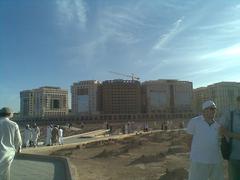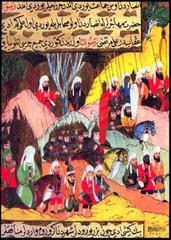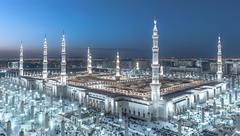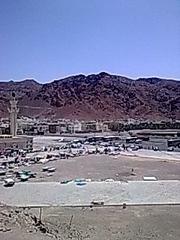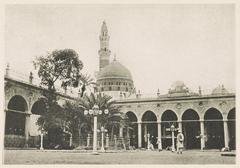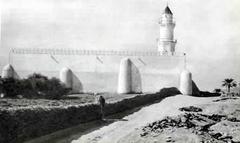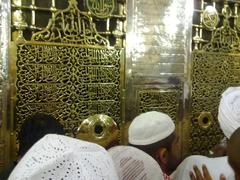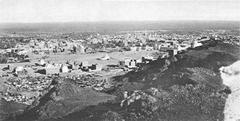The Seven Mosques of Medina: Visiting Hours, Tickets, History, and Travel Guide
Date: 14/06/2025
Introduction
The Seven Mosques, known as Saba Masajid, form a historically and spiritually significant cluster on the western edge of Mount Sala’ in Medina, Saudi Arabia. Deeply connected to the Battle of the Trench (Ghazwat al-Khandaq) of 627 CE, these mosques commemorate the sites where the Prophet Muhammad (PBUH) and his companions prayed or took strategic positions during this pivotal moment in Islamic history. Although called the “Seven Mosques,” the complex currently consists of six mosques, with historical debate surrounding the identity of the seventh.
For visitors, the Seven Mosques offer not only a window into Medina’s early Islamic architecture but also a tangible connection to themes of resilience, faith, and unity. The site is approximately 2–5 kilometers from the Prophet’s Mosque (Al-Masjid an-Nabawi), making it accessible by foot, taxi, or car. Beyond their religious significance, the Seven Mosques and their surroundings provide panoramic views and a tranquil atmosphere, especially at Masjid Al-Fath atop Mount Sela.
This comprehensive guide explores the historical context, individual significance of each mosque, practical visitor information, etiquette, and nearby attractions, ensuring a respectful and enriching experience for all travelers (TravelSetu, MedinaHotels, 3rooj.com).
Table of Contents
- Origins and Historical Context
- The Seven Mosques: Individual Histories
- Religious Significance
- Visitor Information
- Getting There
- Nearby Attractions
- Preservation and Tourism
- FAQ
- Conclusion and Visitor Tips
- References
Origins and Historical Context
The Seven Mosques are located near the ancient battlefield of the Battle of the Trench, a turning point in early Islamic history. During this event, a defensive trench was dug around Medina, and these mosques mark the positions or prayer sites of the Prophet Muhammad (PBUH) and his companions. Each mosque is associated with a key figure or specific event from the battle, serving as a living testament to faith and perseverance (TravelSetu).
Although termed “Seven Mosques,” only six structures remain today. The seventh is variably identified as Masjid Al-Fath, Masjid Al-Qiblatayn, or Masjid Al-Khandaq, depending on historical interpretation.
The Seven Mosques: Individual Histories
| Mosque Name | Associated Figure/Event | Historical Significance |
|---|---|---|
| Masjid Al-Fath | Prophet Muhammad (PBUH) | Site of prayer for victory during the battle |
| Masjid Salman Al-Farsi | Salman Al-Farsi | Honors the companion who proposed digging the trench |
| Masjid Abu Bakr | Abu Bakr Al-Siddiq | Prayer site of the first Caliph |
| Masjid Umar | Umar ibn Al-Khattab | Prayer site of the second Caliph |
| Masjid Ali | Ali ibn Abi Talib | Prayer site of the Prophet’s cousin and son-in-law |
| Masjid Fatimah | Fatimah Az-Zahra/Saad ibn Muadh | Honors the Prophet’s daughter or a local leader |
| Masjid Saad ibn Muadh* | Saad ibn Muadh | Sometimes counted as the seventh mosque |
*The seventh mosque’s identity varies by tradition.
Architectural Highlights:
- All mosques feature local stone construction, simple layouts, small domes, and single minarets.
- Ottoman-era renovations have preserved their authenticity.
- Masjid Al-Fath is the largest and sits atop Mount Sela, offering panoramic views.
- Masjid Fatimah is the smallest, notable for its minimal ornamentation.
For detailed profiles and visual features of each mosque, refer to 3rooj.com and madainproject.com.
Religious Significance
While there is no explicit Islamic injunction to visit the Seven Mosques, they are revered for their association with the Prophet’s life and the sacrifices made during the Battle of the Trench. They symbolize unity, faith, and resilience, attracting visitors especially during Hajj and Umrah (MedinaHotels).
Visitor Information
Visiting Hours
- Open daily from dawn (Fajr) until dusk, generally 7:00 AM to 7:00 PM.
- Best times to visit are early morning or late afternoon to avoid midday heat.
Tickets and Entry
- Entry is free of charge.
- No advance booking needed, but check locally for updates during special events or religious holidays.
Accessibility
- The site is pedestrian-friendly, connected by paved walkways along Khalid Ibn Al Walid Road.
- Some mosques have ramps, but terrain may be challenging for those with mobility issues.
- Public restrooms and ablution facilities are available nearby.
Dress Code and Etiquette
- Modest attire is mandatory: Women should wear an abaya and cover their hair; men should avoid shorts and sleeveless shirts (The Wandering Quinn).
- Shoes must be removed before entering prayer halls.
- Maintain silence and respect; avoid loud conversations and disruptive behavior.
- Photography is generally allowed outside the mosques but is restricted inside (CuddlyNest).
- Observe prayer times and avoid entering during congregational prayers.
- Gender segregation is strictly observed; follow signage and staff guidance.
Guided Tours and Photography
- Guided tours are available and recommended for historical context.
- Early morning or late afternoon provides the best lighting for photography.
- For more on etiquette and visitor guidelines, see The Islamic Information.
Getting There
- From airport: Prince Mohammad Bin Abdulaziz International Airport (MED) is the nearest airport; taxis and ride-hailing apps provide easy transport.
- From Medina center: The mosques are 2–5 km from Al-Masjid an-Nabawi; taxis, private cars, or walking (in cooler months) are all viable.
- Public transport: Limited; taxis remain the most efficient option (TravelSetu).
Nearby Attractions
- Al-Masjid an-Nabawi (The Prophet’s Mosque): Second holiest site in Islam, iconic Green Dome, vast prayer halls (mytravelation.com).
- Quba Mosque: First mosque in Islamic history, tranquil atmosphere (mytravelation.com).
- Qiblatain Mosque: Marks change of prayer direction from Jerusalem to Mecca.
- Uhud Mountain: Site of the Battle of Uhud, panoramic views and graves of martyrs.
- Jannat al-Baqi Cemetery: Resting place of the Prophet’s family and companions.
- Museums: AlMadina Museum, Dar Al Madinah Museum, Hejaz Railway Museum.
- Leisure and Shopping: King Fahd Central Park, Al Noor Mall, Dates Market, Al-Aqiq Valley.
For more details on attractions, visit travelsetu.com and wanderlog.com.
Preservation and Tourism
Saudi authorities have invested in restoration and landscaping to preserve these sites, aligning with Vision 2030’s commitment to cultural tourism. The area is safe, with security personnel present, and is well-maintained for both pilgrims and tourists (TravelSetu).
FAQ
Q: Are tickets required for entry?
A: No, entry is free.
Q: What are the visiting hours?
A: Daily from dawn until dusk; check locally for updates during religious events.
Q: Can non-Muslims visit the Seven Mosques?
A: Non-Muslims can visit the surrounding areas but not the mosque interiors.
Q: Are guided tours available?
A: Yes, local operators offer tours with historical context.
Q: Is photography allowed?
A: Yes, outside the mosques; interior photography is generally restricted.
Q: Is the site accessible for people with disabilities?
A: Some ramps are present, but terrain can be uneven; assistance may be required.
Conclusion and Visitor Tips
The Seven Mosques of Medina offer a unique blend of history, spirituality, and cultural immersion. With free entry, flexible visiting hours, and proximity to other major sites, they are a must-visit for pilgrims and history enthusiasts alike. Adhering to dress codes, mosque etiquette, and local customs ensures a respectful and memorable experience. Enhance your visit by joining a guided tour and exploring Medina’s vibrant cultural landscape.
For up-to-date travel tips and guided tours, consider downloading the Audiala app and exploring our related articles on Medina’s sacred sites.
References
- TravelSetu: Seven Mosques Medina - History and Visitor Guide
- MedinaHotels: Top 6 Islamic Sites in Medina
- 3rooj.com: The Seven Mosques
- mytravelation.com: Medina Guide
- CuddlyNest: Medina Mosque Visitor Experience
- The Wandering Quinn: Visiting Medina as a Non-Muslim
- The Islamic Information: Mosque Etiquette
- madainproject.com: Seven Mosques
- besidestheobvious.net: The Seven Mosques in Medina
- wanderlog.com: Historic Buildings in Medina
